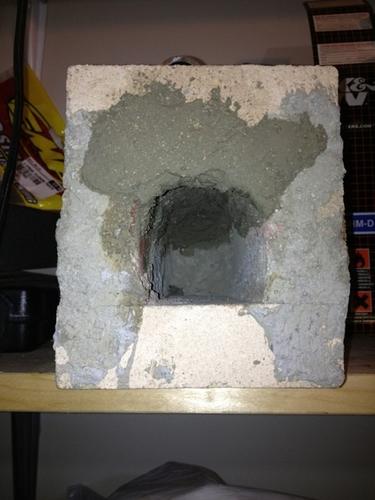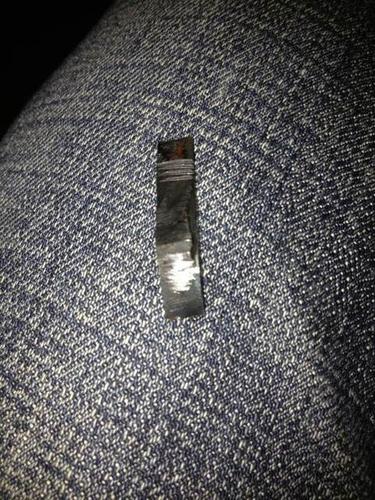Results 11 to 20 of 20
Thread: Insufficient heat for hardening?
-
09-28-2013, 08:39 PM #11"My words are of iron..."


- Join Date
- Oct 2006
- Posts
- 1,898
Thanked: 995
O1 is basically fool proof to heat treat as long as you are getting to the right temperature. If the blades are not hard, e.g. the file is cutting them, then you are not getting hot enough. I agree, putting the blade in the flame from the torch is not a good idea. What may be happening is that your forge is not retaining enough heat to really work correctly. It's not the flame that does the work inside a forge. It's the walls heating up and radiating heat back into the center of the forge. The flame is just going to spot heat the blade or worse will still contain unburnt oxygen and that will mean losing steel to scale or uneven heating and warps as you've already discovered. Let the firebox warm up until it glows well, then put the steel inside. You may need to consider closing off any openings to restrict heat loss and find your forge works better too. All you need is enough space to get the razor through the door into the heat.
Second, use room temperature oil. That the oil does not flare could prove the blade is not hot enough but most oil will flare at 4-500 F so that doesn't mean anything. The mass of a razor is so small that fires are rare in quenching anyway. The warm or hot oil seems common in all the sites that reference heat treating with oil. So the next logical step is to not heat the oil. If you were right at the critical non magnetic temperature the cool oil might kick the blade steel over to martensite where the warm oil would not have enough gradient to make the steel drop below the nose of the hardening curve. But that means you don't have enough heat in the blade. YOu have to beat the nose of the TTT curve in about a second or two with O1. As I said before, don't dawdle between the fire and the quench.
-
09-28-2013, 09:08 PM #12Senior Member

- Join Date
- Mar 2011
- Location
- Corcoran, Minnesota
- Posts
- 665
Thanked: 170
+1 to everything Mike B said. Also, make sure you don't grind your edge too thin before heat treating. If you go too think, the edge will "potatoe chip". ie, warp, and this can't be fixed. Heat treat with the edge about 1/16 to 3/32, and finish the grind after heat treating. From how you described the color of your blade in the forge, you are not getting up to temperature. Look on line for "home made forge burners" which can be made from various pipe fittings, with a .024 wire feed tip for an orofice. Cheap, and they work great. PM me, and include your email address if you want to see a photo. Also, google "one brick forge", if you haven't already. Another thing that works great for small forges is a plumbers torch, that they use to solder pipe fast - much hotter than a Bernzomatic. I'd also suggest rough polishing out more of the grinding scratches before heat treating - much easier than when the blade has been hardened. Good luck on your journey! You have learned a lot already.
-
09-28-2013, 09:41 PM #13

Given your description, I am guessing that you really don't get hot enough.
You should be able to make the entire blade glow a nice even orange along the entire length.
If that is not happening, you need more fire.
Putting it directly in the flame is not a good idea.Til shade is gone, til water is gone, Into the shadow with teeth bared, screaming defiance with the last breath.
To spit in Sightblinder’s eye on the Last Day
-
09-30-2013, 04:22 AM #14

Thanks, all. I have added some cast able refractory cement to the ceiling of the forge and constricted the opening a bit. Will try later.
Mean time, I tried heat treating a scrap of O2 directly in a propane flame to orange-red and dropped it immediately into room temp oil from about 6", straight from the flame.
The scrap appears to have hardened but the file still leaves marks. Not grinding marks but metal is clearly displaced if not actually cut. Just trying to understand exactly what 'skating' really means.



-
09-30-2013, 05:15 AM #15

Try one file on another and you'll see what skating is, don't use your best files tho.
Hur Svenska stålet biter kom låt oss pröfva på.
-
09-30-2013, 09:49 AM #16

Or take an old crummy solingen blade. Try to file the spine and see what happens.
In principle, you could use sheffield blades as well, but I've had sheffield blades that had a relatively soft spine / tang.
Soling blades otoh are almost invariably 60+ in HRcTil shade is gone, til water is gone, Into the shadow with teeth bared, screaming defiance with the last breath.
To spit in Sightblinder’s eye on the Last Day
-
10-01-2013, 02:14 AM #17The First Cut is the Deepest!


- Join Date
- Feb 2010
- Location
- Upper Middle Slobovia NY
- Posts
- 2,736
Thanked: 480
I am using an "insta-forge" that is working fine for me using a similar style torch. I believe the Bernzo8000 puts out the same as my TurboTorch.
What I am reading is that your forge is a simple brick and cement, with no layer of actual insulation to prevent the heat from radiating outwards. Combine this heat loss with the added heat sink of a piece of steel for the floor, and you probably are not generating enough heat too raise temp as fast as you are loosing it. How big is that steel flooring?, does it stick outside of the forge when you are working? Let the forge run full on for 15 minutes before putting your blade in. If the forge is not up to temperature, by then, you may need to add a second (or larger) torch.
here is a link to my forge just so you can see it if you care to look.
http://straightrazorpalace.com/forge...rst-forge.html
-
10-01-2013, 02:28 AM #18

Mine is fire brick and cast able refractory, but I think you are right about the heat loss through the brick and metal tray. I might try holding simply by tongs/pliers. The thicker refractory on the ceiling should help.
Man, those dense fire bricks are crappy.
-
10-01-2013, 02:31 AM #19

I am also going to make one like yours... I already have the ceramic wool and coffee can, and might just have enough castable refractory to finish it.
-
10-05-2013, 06:31 PM #20

I think I have done it! I realized the torch heat was not working well from the back so I tried to think outside the firebox. Sorry. I lit the torch and held in front of the opening from about an inch or so outside. This let me heat from the heel and still let gases escape out the hole in the back of the forge (had to be a bit careful not to suffocate the combustion). I was also able to keep the flame on the blade while transferring to the oil. They were red hot and the file sounds different across the metal now.
I treated all four blades and then went back to the grinder for touch-ups, and they are now resting in the oven at 400 for two hours.
Tapatalk doesn't want to upload my photos, but the blades are on a fire brick in the oven.
I think I will go back to my original thread for razor creation updates. Thanks, all.
Cheers!


 3Likes
3Likes LinkBack URL
LinkBack URL About LinkBacks
About LinkBacks







 Reply With Quote
Reply With Quote

